为什么我感到如此孤独?
Why Do I Feel So Lonely?
When we think of what might have been lost on the way to becoming modern, we’re liable to think about mealtimes: how seldom they now take place communally, how rare it is for whole families to gather, how much technology can intrude. In paintings of communal meals that reflect the older way of doing things, we can appreciate how all ages used to come together around a table, what a joy the home prepared food was and how welcoming the atmosphere seems to have been. Even the family horse might have been invited to join in.
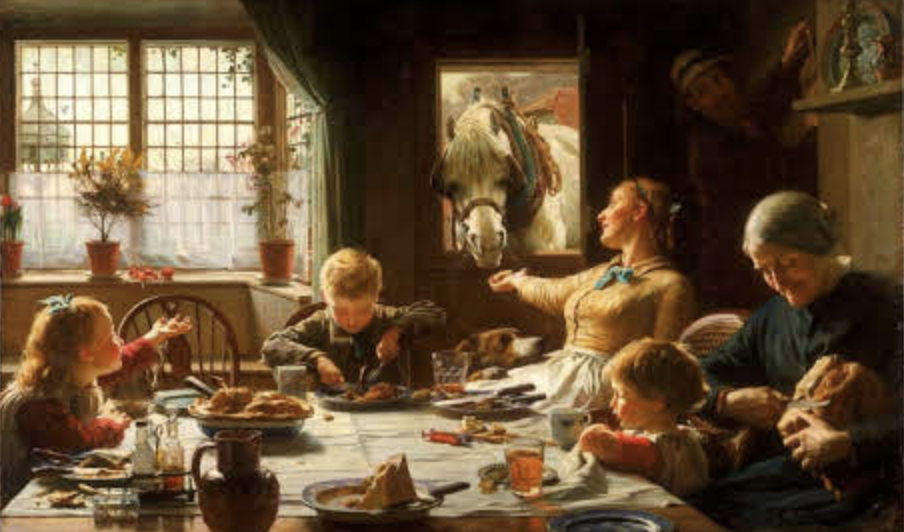
Frederick George Cotman, One of the Family, 1880
The modern condition appears infinitely bleaker by comparison. Rather than a family around the hearth, the emblematic image is of a single person with a tray on their trees in front of the television. It was the Swanson Corporation, originally a poultry producer in Omaha, Nebraska, that launched the frozen TV dinner in 1954, the same year colour television was introduced in the United States. The dinner came with two slices of turkey breast, sweet potatoes, buttered peas and cornbread dressing. The company had plans to sell five thousand in the first year; in the event, they sold ten million.

Swanson Corporation, Turkey Dinner, 1962
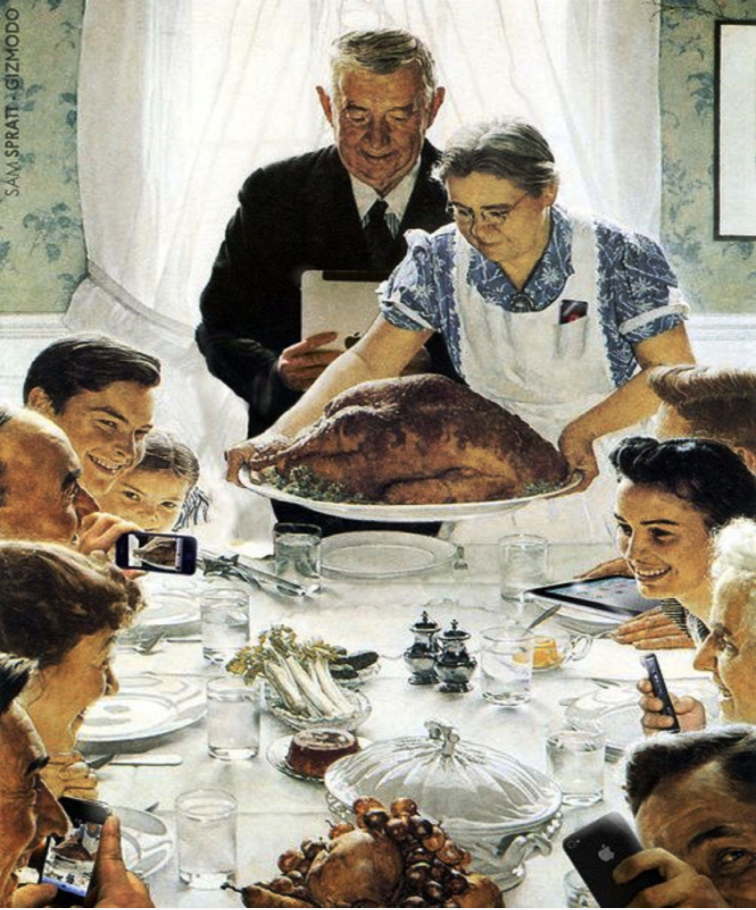
Norman Rockwell, Thanksgiving 1943
Modernity is surely a lonelier place than the world that preceded it. The question is why. Frozen dinners are an easy target – but these precisely engineered trays are more likely to be symptoms of our unease about solitude than causes of alienation in themselves. It isn’t ultimately technology (cities, cars or screens) that have made us lonely; it’s an identifiable set of ideas. Being on one’s own doesn’t have to be problematic, demeaning or say anything sinister about one’s character. Yet we have in a variety of ways made this the firm equation. Loneliness does not arise simply because one happens to be physically isolated; it’s caused when our culture encourages to feel a sense of shame at being so. We have rendered ourselves lonely first and foremost because of certain stories we have started to tell ourselves about what loneliness means.
Most eras before our own knew that solitude did not – per se – have to be a sign of wretchedness or deficiency. There were ways of being one one’s own that could be filled with honour and an impression of communion with what is noble and sincere; physical isolation could be accompanied by a strong sense of connection with a god, a person in a book, a piece of music or a quieter part of one’s own mind. One could be alone and at the same time not feel isolated or damned – just as one might be surrounded by family and yet feel painfully unseen and unheard.
In the early history of Christianity, it was believed that true sociability didn’t involve chatting to whomever happened to be in the vicinity (our blood relatives or people we went to school with).At the height of monasticism in the Middle Ages, it was estimated that a million people across Europe and north Africa had chosen to forego the bustle of family and commerce in order to dwell, in some of the most rugged and remote terrain in the world, in silent contemplation of the beauty of the divine spirit.
However, in the wake of the Reformation and the destruction of the monasteries that accompanied it, solitary piety began to lose its prestige and recede as a practical option. Those who had previously lived alone at the tops of mountains were now encouraged to serve God by remaining in the community, finding a suitable spouse – and starting a family. There was an increasing sense that to be solitary might slide over into selfishness or be evidence of an overzealous mind.
To this newly social religious impetus was added the influence of Romanticism, a movement of ideas that – with different ends in view – similarly encouraged people to give up on thorough commitments to their own company and questioned the honour of solitude. For the Romantics, happiness lay in identifying one exceptional soulmate to whom one could surrender one’s independence and with whom one might fuse mind and body. With a genuine lover by one’s side, one would never again need to feel sorrow or dislocation, one would at last understand one’s purpose and appreciate one’s place: one would have come home.
The Romantics painted a hugely moving portrait of coupledom – and thanks to their artistry and the examples of their own lives, they convinced the modern world. But in the process, the Romantic movement had a catastrophic effect on our assessment of what it might mean to remain by ourselves. Romanticism turned solitude from a respectable and profound choice, to evidence of pathology. It seemed, through the lens of Romanticism, that there could be no other reason why a person might have opted to be by themselves other than because they were in some way exceptionally emotionally diseased or sexually deviant. ‘Those who have never known the deep intimacy and the intense companionship of happy mutual love have missed the best thing that life has to give,’ explained the Romantic (and four-times married) philosopher Betrand Russell. It sounded encouraging. It was also, beneath the surface, a characteristic threat of the Romantic era.
By propagandising so successfully on behalf of conjugality, Romanticism guaranteed that those who were on their own would have no option but to be left doubting their goodness and sanity – and might end up a great deal more isolated than a Desert Father after half a century of silence in the Nitrian desert.
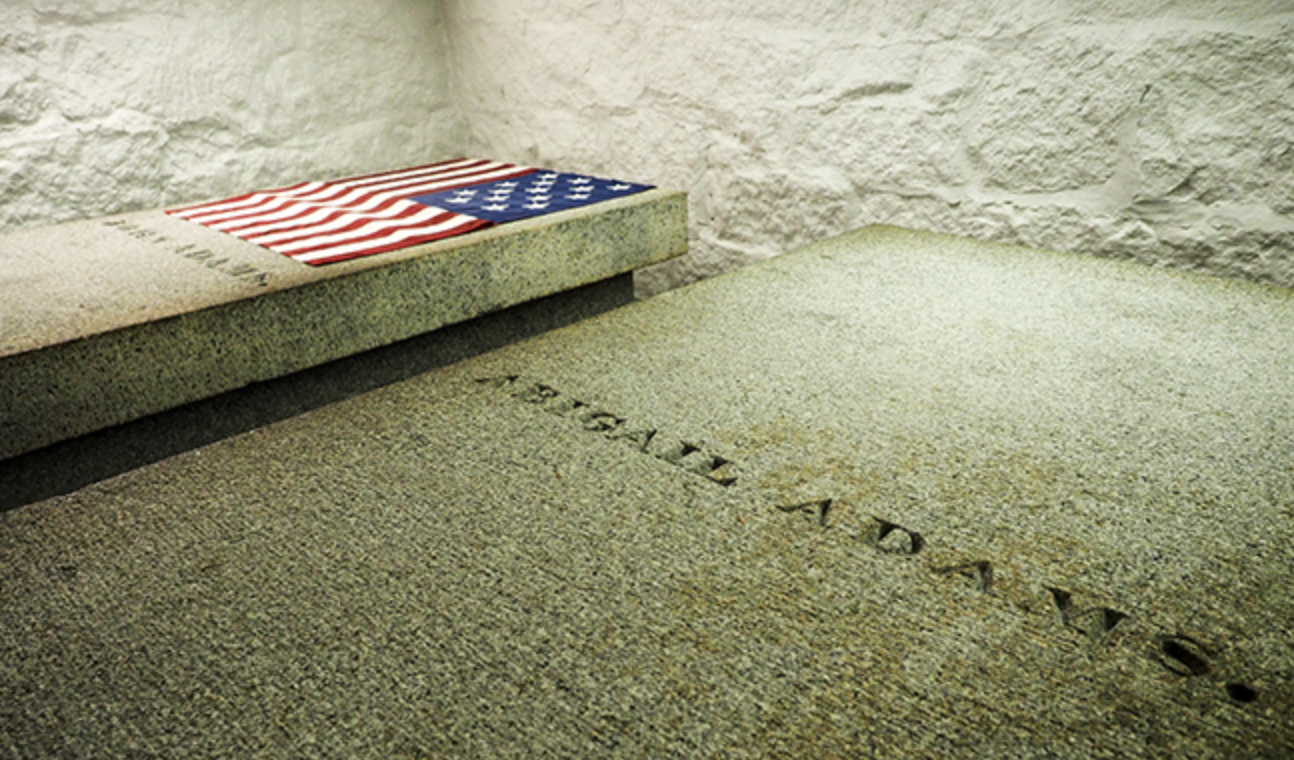
In a couple forever: Abigail and John Adams, Buried alongside each other, Quincy, Massachusetts.
Romanticism didn’t just make single people feel freakish; it massively increased the pressure on anyone already in a couple who couldn’t lay claim to extreme contentment with their partner; it made those who were merely quietly muddling along and politely putting up with some less than ideal habits and routines feel lonelier and more cursed than they had ever done. For most of history, no one had expected couples to be very content; forebearance and compromise had been praised as the true achievements.

William Orchardson, The Marriage of Convenience, 1883
Romanticism trapped the human race in a double bind: by framing singlehood as psychologically impossible, it encouraged us to panic and accept marriage proposals that it would have been wiser to resist. But at the same time, by suggesting that ongoing fascination and bliss were the norm within every decent relationship, it made the vast majority of couples feel as if they had somewhere along the line gone very badly wrong.
The tensions came to a head in Britain after the First World War. Following the loss of life in the conflict, a census revealed that women now outnumbered men by 1.75 million. The newspapers spoke in alarmed voices of ‘Two million surplus women.’ There was no sense that failing to get married offered – on balance – as many opportunities and sorrows as being so; there was no admission that there might be loneliness in both camps and that the unmarried variety might on occasion be preferable. The ‘war spinsters’ as they became known were treated with a mixture of derision and charity. An Oversea Emigration Committee was set up with the express purpose of encouraging single British women to travel to distant parts of the Empire, to escape the ignominy of a solitary life at home. For a generation thereafter, the ‘spinster’ or ‘maiden aunt’ was a stock character to mock and feel sorry for. It simply seemed inconceivable that one could have, at once, a tolerable life and no husband.
When the Beatles released Eleanor Rigby in 1966, the song that more than any other defined what loneliness meant for the modern age, it was at once clear why Eleanor was a lamentable figure. The famous face that she kept in a jar by the door had been intended for the enchanting partner that, like all single people, she must have longed to find. Only with romantic love could there be a decent life, so ran the philosophy of the song, of all the Beatles’ works and in fact, of every modern pop song every written.
The modern world not only made it mandatory to have a partner. It made it feel essential to have a vibrant gang of friends – and to enjoy seeing them regularly at parties. Opportunities for large scale socialising grew with the development of electric lighting, restaurants, dance halls and bars. Weekends were newly devoted to going out – and an otherwise unknown form of anxiety began to grow if, as Saturday evening approached, one realised one had nowhere in particular to go in the fun-filled city. An empty diary became an emblem of deformity.
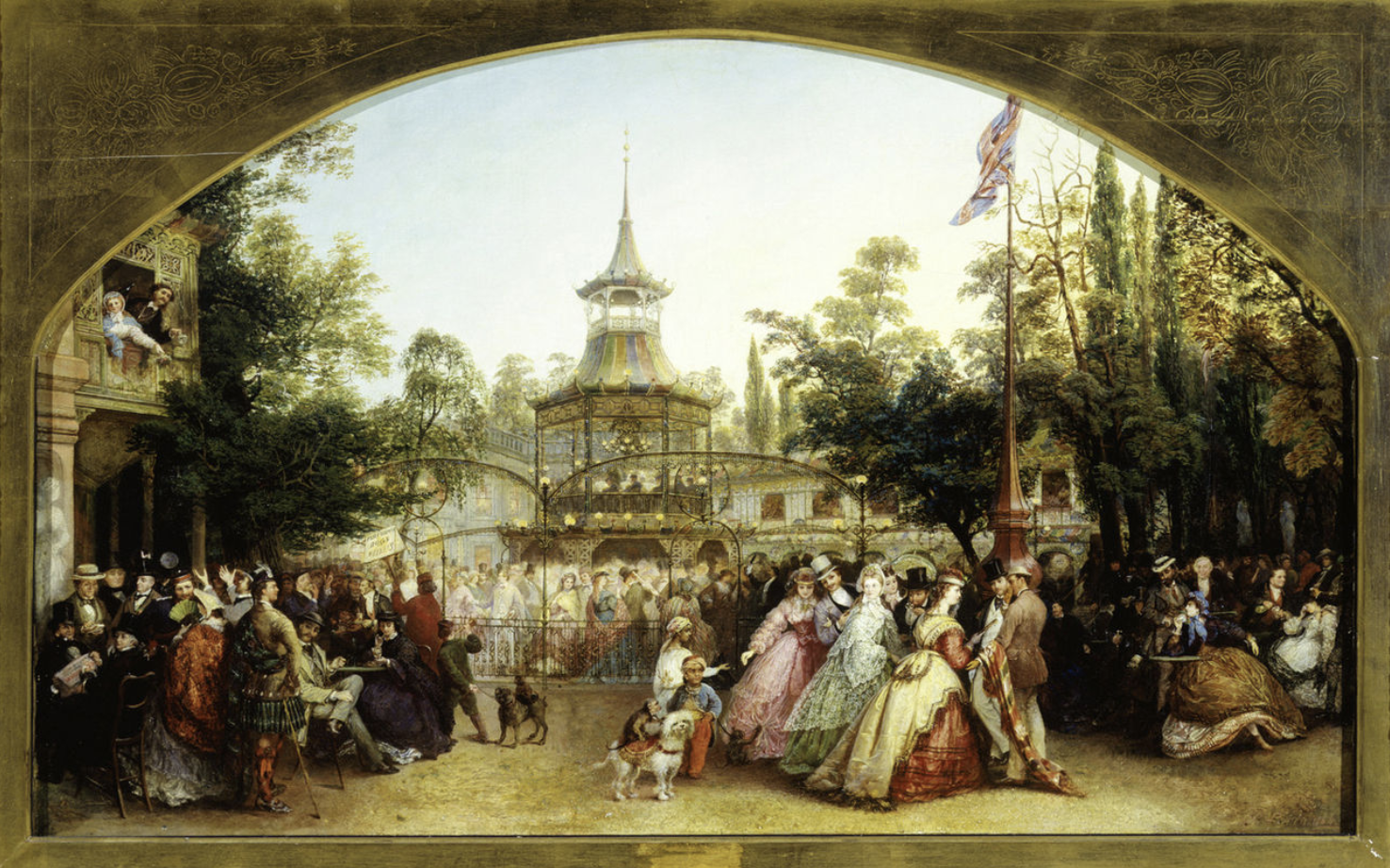
Phoebus Levin, The Dancing Platform at Cremorne Gardens, 1864
Newspapers grew filled with reports of the social lives of others. One could find out who had attended Elizabeth Taylor’s 40th-Birthday Party and what had been served at Marie-Helene de Rothschild’s Proust Ball, what the most beautiful dress was at The Met Gala and how Valentino had done the seating plan at his White Fairy Tale Love Party. But more importantly, we were being subtly schooled in the notion that to be respectable would be to love going out; that there was no glamour in staying in with a book and no value in collecting one’s thoughts in a diary or turning over one’s memories of childhood in a hot bath. At the same time, there was not the slightest admission that it might, all things considered, be a distinctly curious way of living up to one’s ideals of community to stand in a crowded room full of status-panicked, socially-anxious people, every one of them terrified of honesty or failure – where the only possible answer to a shiny enquiry of how one was doing was a vigorous ‘absolutely terrific – and how are you?’
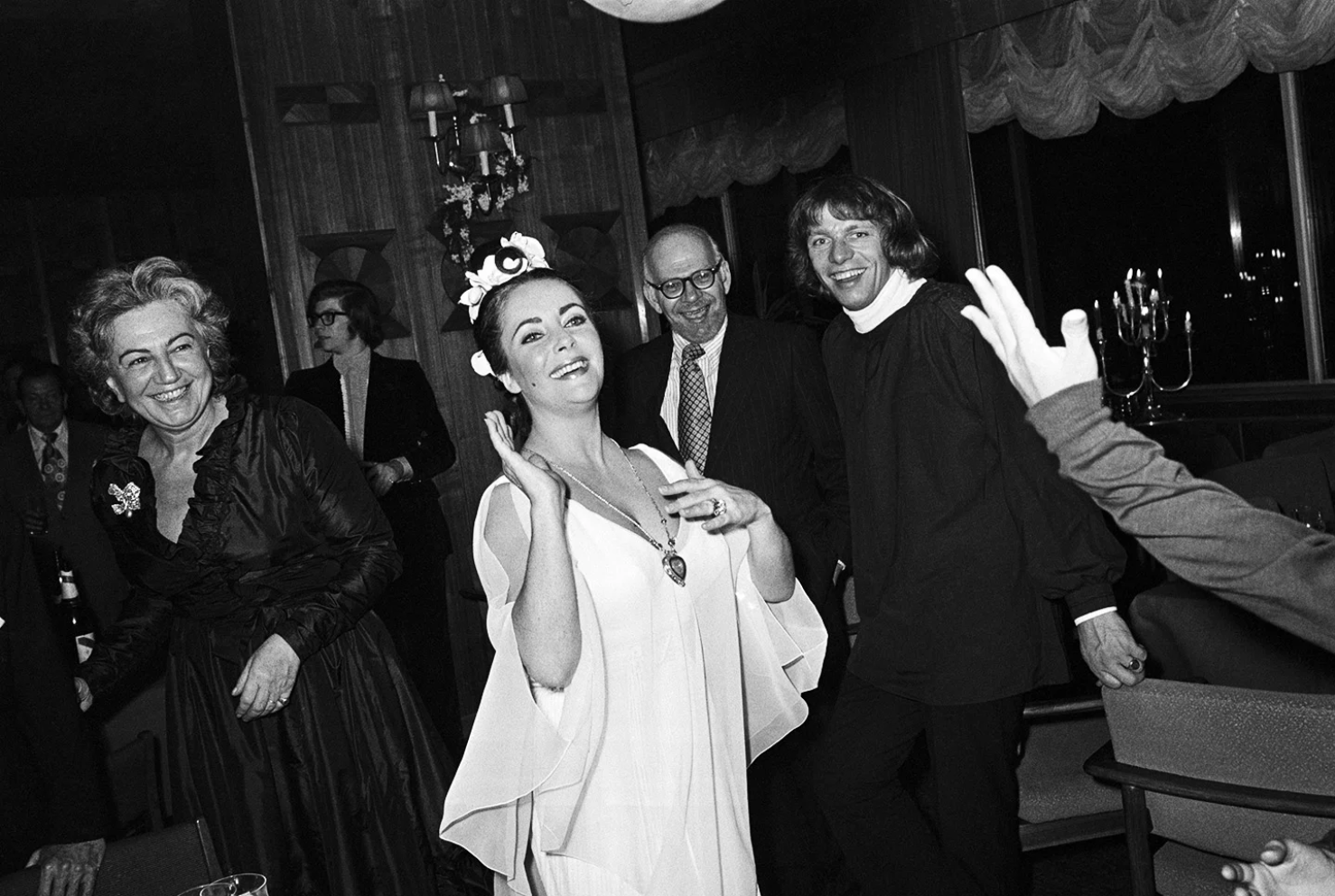
In 1921, Carl Jung – in his book Psychological Types – had introduced the terms ‘extraverted’ and ‘introverted’ to divide humanity. The former referred to a sort of person who could best realise their potential in the company of others; the latter were those who needed to move away from crowds and idle chatter in order to regain their integrity. ‘Everyone possesses both mechanisms,’ wrote Jung – but it was evident where the spirit of the age resided; the modern world belonged to the extroverts, while the introverts were left at home to feel as if what they most enjoyed – being by themselves – was a disease.
It was of course nothing of the sort. But in order to feel less lonely, we don’t – most of us – need to be pushed into going out again or given yet more encouragement to track down perfect lovers; we need society to change its stories about what solitude can mean. We need to shift the associations we have been given – away from failure and freakishness towards depth and discernment. Feeling that one doesn’t want to stand in a loud room chatting with people, that one wants to have a simple meal on one’s own, that one wants to be left with a pad of paper, that one wants to walk in nature, these are no signs of madness. They are primary evidence of a complex and rewarding interior.
It’s been the achievement of a few, often at the time ignored artists of the modern period to make a case for the other side, to speak up with due confidence and skill for introversion, to try to coat solitude in glamour. In a painting by Caspar David Friedrich, we are invited to trust that the lonely figure in the landscape is no outlaw or brigand; he is privy to insights that would be lost in the crowd down in the lowlands, he has needed to travel up to the mountains in order to put the bluster and envy of humans into perspective; on his own, the wanderer can be returned to the most significant parts of himself. We should dare to follow him in his trajectory.

Caspar David Friedrich, Landscape with Mountain Lake, Morning, 1823
In Corot’s art, solitude is not some poor alternative to company, it is not what one might turn to when, and only when, one had been rejected from a gala dinner or one’s prospective husband has been killed in battle. Solitude is a paradise from which every noisy greeting, every superficial remark and every insensitive encounter is a painful rupture we should be proud to resist.

Jean-Baptiste Corot, Solitude, 1866
Gwen John’s young woman doesn’t seem to belong to any official religion. But if there were one dedicated to the appreciation of solitude, she would be one of its saintly and legendary figures. Her expression – kind, gentle, melancholy and lost in profundity – is an advertisement for all that modernity has neglected in its promotion of active, cheery lives.
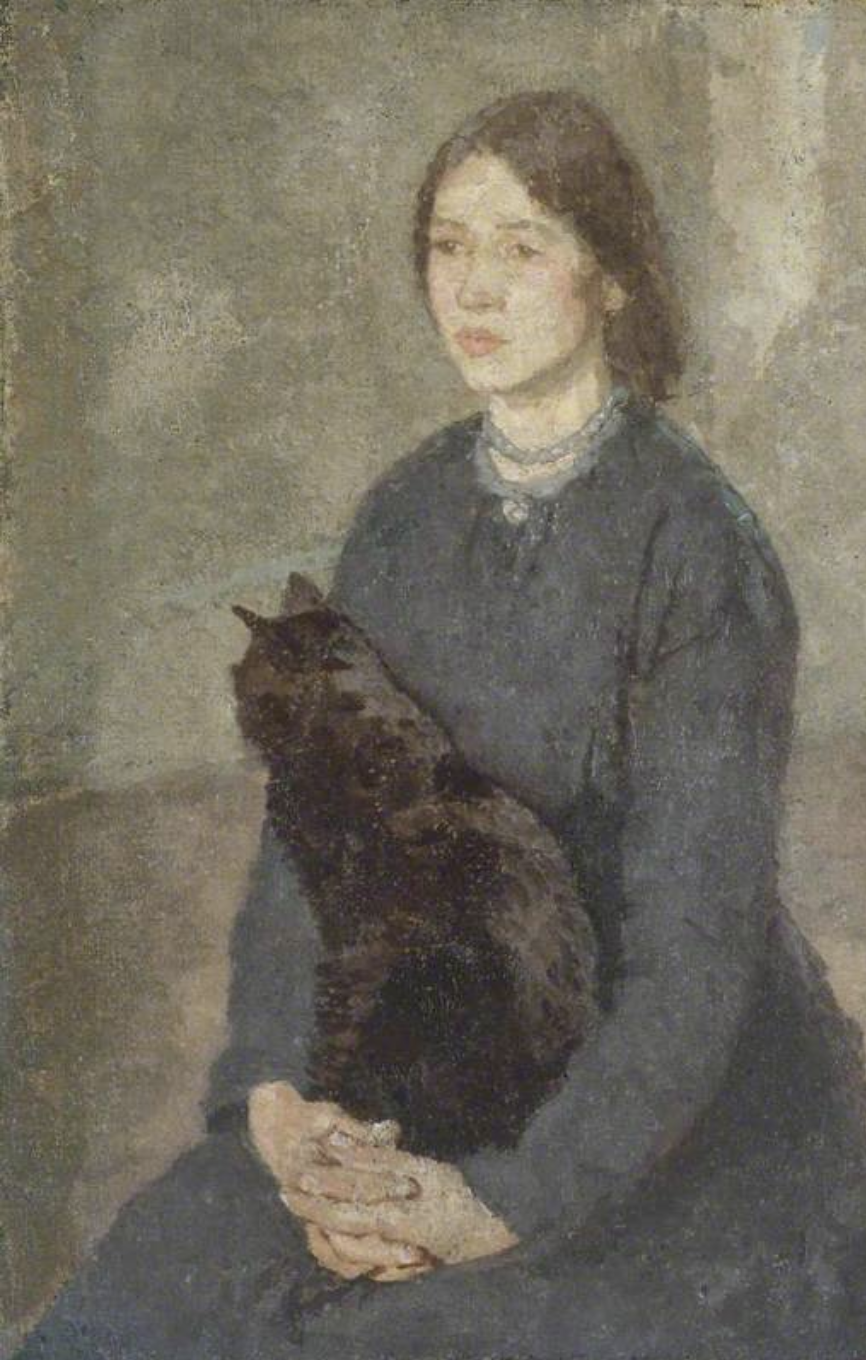
Gwen John, Young Woman holding a black cat, 1920
Separated by eight decades, the leading figure in Hannah Starkey’s photograph of a diner seems similarly to make an eloquent case for isolation. The setting may be bleak, but the picture is anything but – perhaps because it allows us to remember, and better hold on to, our own experiences of solitude, when being by ourselves is not some form of punishment, but a chance to digest griefs, to recenter ourselves and to escape a hypocritical and tyrannical world – always keen for us to join in its raucous enthusiasms and sentimental moods. Despite the starkness of the furnishings, the location itself does not seem wretched. Others in the room may be on their own, men and women drinking coffee or a Coke by themselves, similarly lost in thought, similarly distanced from society: a common isolation with the beneficial effect of lessening the oppressive sense within any one person that they are alone in being alone. Isolation isn’t a particular malediction; it’s where good people tend to end up.

Hannah Starkey, Untitled, October 1998
We should feel proud to be the descendants and the spiritual twins of the people in the great solitary works of art. We should dare to believe that we are in solitude not because we are ill but because we are noble of spirit – because our ideals of sociability are higher than anything our world is able to provide. We don’t hate company; it’s just that we would prefer to stay home rather than accept the counterfeit tokens of community presently on offer.
The way to make people feel less alone isn’t to pull them out of their musings in the forest or in the diner, in the library or the desert – and force them to go bowling. It’s to reassure them that being alone is no sign of failure. To lessen modernity’s crisis of loneliness, we need for solitude to be rehabilitated and for singlehood to regain its dignity. There is nothing catastrophic about eating dinner, many dinners, on our own. The Swanson TV dinners might have been capable of improvement, but it is ultimately far better to be eating a basic meal in peace than to be in a ballroom surrounded by false smiles and oppressive judgements. When we do so, we aren’t in fact on our own at all. We are – as modernity has failed to remind us – dining with some of the finest, most elevated spirits who have ever lived. We are, though ostensibly by ourselves, in the very best company.
更多精彩详细内容请关注小译号 The Book of Life